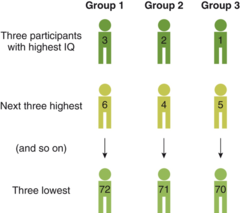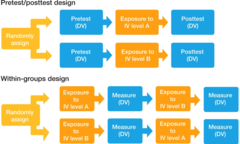Psych Chapter 10 – Flashcards with Answers
Unlock all answers in this set
Unlock answersquestion
Why do we conduct experiments?
answer
Because we would like to understand as much as we can about the nature of a relationship between two variables so that we can possibly influence some outcome
question
Example: Seeing red Background
answer
Red has many connotations, mostly negative Psychologist Andrew Elliot wanted to test whether the color red impacted performance on a test The theory was based on an approach/avoid orientation in achievement Approach - strive to get answers right; excited about challenge Avoid - try not to fail; anxiety
question
Example: Seeing red Experiment
answer
Hypothesis: exposing students to red on a test causes them to withdraw and perform worse on a test Tested with an Experiment: 71 students in a lab 5-minute test unscrambling anagrams Identical tests except that the student ID numbers were written in either red, green or black ink on the inside of the test booklet Students were randomly assigned to the conditions
question
Example 2: eating pasta Experiment
answer
Experiment looking at the impact that size of container influences how much we eat. Students at Cornell University's Food and Brand Lab were studied Randomly assigned to a large bowl and medium bowl condition Participants who served themselves from a large bowl took more and ate more, compared to those who served themselves from a medium bowl.
question
What are the three types of experimental variable?
answer
Independent, dependent, control
question
Independent variable
answer
manipulated variable
question
Dependent Variable
answer
measured variable
question
control variables
answer
held constant on purpose so they cannot explain the change in the DV
question
How can meet the three causal rules?
answer
Covariance Temporal precedence Internal validity
question
Example of covariance being met with an experiment
answer
In the Elliot study, covariance was seen between the causal variable (color of ID number) and effect variable (performance on the anagram test) The covariance was explained by the difference in means of the two groups.
question
Independent variables have to vary in order to establish
answer
covariance YOU NEED COMPARISON GROUPS
question
Groups that can be used to prove covariance
answer
Control, treatment, comparison, and placebo
question
Control group
answer
a level of the IV that represents "no treatment" or a neutral condition
question
treatment group
answer
levels of the IV that receive the treatment
question
comparison groups
answer
including different conditions like green and black ink - not a control group because it's not really the absence of red
question
placebo group
answer
a control group that is exposed to an inert treatment, like a sugar pill
question
How experiments prove temporal precedence?
answer
since the IV is manipulated, it comes before the DV. The cause comes before the effect Better then a correlational study where the variables are measured at the same time
question
How experiments have internal validity?
answer
The most important! Allows us to rule out other explanations for the change in the dependent variable For example: In the Elliott anagram experiment to rule out other explanations for the difference in performance the researchers made sure that all conditions - the anagrams, the researchers attitudes, the test forms, even which condition the participants were in was unknown to the researcher - were kept the same
question
Internal validity issues
answer
design confound systematic variability selection effects
question
design confound
answer
a second variable that varies systematically with the independent variable ex. , if Elliot had given the red ink group more difficult anagrams than the other groups the difficulty of the test would have been a design confound
question
systematic variabilty
answer
when the variability is uneven across groups; like if only the unfriendly research assistants are assigned to the red ink condition
question
Unsystematic Variability (does not harm)
answer
variability that is random across conditions Does not harm internal validity but can cause other issues
question
Selection effects
answer
When the kind of participants at one level of the independent variable are systematically different than at the other levels Can happen then participants are allowed to choose which condition that they want to be in
question
Example of selection effects
answer
Study designed to test new therapy for autism One-on-one sessions with a therapist for 40 hours per week Some children received new treatment, some their standard treatment Families allowed to select condition Clear selection effect - families who are willing to devote 40 hours are probably working more with their children Selection is a clear confound in this instance
question
Avoid selection effects with _______ and __________

answer
random assignment matched groups
question
Types of group designs
answer
Independent Group and Within Group
question
Independent Groups Designs
answer
Different groups of participants are assigned to different levels of the independent variable Also called between-subjects and between-groups designs
question
Within Groups Designs
answer
Only one group of participants & each participant is assigned to all levels of the independent variable Also called within-subjects design
question
Types of Independent-groups designs
answer
Posttest only and Pretest/Posttest
question
Is pretest/posttest or posttest-only better?
answer
They both support causation In some situations, like the pasta experiment, a pre-test is not possible Random assignment helps ensure that confounding variables are evenly distributed between groups - like appetite
question
Types of Within groups designs
answer
concurrent-measures and repeated measures
question
concurrent-measures

answer
participants are exposed to all levels of the independent variable at about the same time Babies saw two faces simultaneously, and the experimenters recorded which face they looked at the longest.
question
repeated-measures

answer
participants are measured on the dependent variable more than one time - after exposure to each level of the independent variable Oxytocin is a bio-chemical thought to be important in social bonding. Mothers oxytocin levels were measured with their own 2 or 3 year old toddlers and then again several days later with another infant. Levels were found to be higher with the new toddler.
question
Four basic designs summary
answer
Interdependent-groups - Posttest - Pretest/Posttest Within-Groups -Concurrent -Repeated
question
Pros and cons of Independent-groups designs
answer
Pros: No contamination across independent variable levels Cons: Require more people
question
Pros and cons of within-groups designs
answer
Pros: Require fewer people Individuals serve as their own control Cons: Potential order effects, chance of experimental demand
question
Within-groups designs another advantage
answer
Power - the ability of a sample to show a statistically significant result when something is truly going on in the population within-groups have more power Noisy party - makes it hard to hear conversations even when they are going on
question
Within-groups are good for two tests for causality but pose a threat to one of them:
answer
Good for covariance, temporal precedence major threat to internal validity: order effects
question
Order effects

answer
Participants' later responses are systematically affected by their earlier ones (fatigue, practice, or contrast effects) Also called practice effects or carryover effects Correction: Counterbalancing
question
Two methods of counterbalancing
answer
Full and partial
question
Within groups disadvantages
answer
1. Order effects - fix with counterbalancing 2. People can change their behavior depending on exposure to previous conditions 2a. Could be demand conditions - participants try to act like "good participants" 3. Within-groups design might not be possible - two methods of training someone to ride a bike, cannot un-teach a person how to ride a bike 2a
question
Is the Pretest/Posttest Design a Within-Groups Design?

answer
no. Because in a true within-groups design, each participant gets every level of the independent variable
question
Interrogating Causal Claims with the Four Validities
answer
Construct validity External validity Statistical validity Internal validity
question
Construct Validity
answer
How well were the variables measured and manipulated? - Is the measure a good representation of the construct of interest? - How well was the independent variable manipulated?
question
Manipulation Checks
answer
an extra dependent variable that a researcher can insert into an experiment to help them quantify how well an experimental manipulation worked
question
Pilot Study
answer
a simple study using different participants, usually before a full-blown study to test a manipulation
question
Theory Testing
answer
- For construct validity, the operationalizations of both the independent and dependent variables are assessed - The standard is typically the theory that the researcher is testing - For the experiment about color and avoidance orientation, critics could argue that the experiment came out the way that it did because the color red is a warm color, not a threat. So Elliot and colleagues added a warm color - orange - to improve construct validity
question
External validity
answer
To whom or to what can the causal claim generalize? - Generalizing to other people - random sampling versus random assignment - Generalizing to other situations - takes more than 1 study to generalize
question
Statistical validity
answer
How well do the data support your causal conclusion? Are the results statistically significant? What is the effect size?
question
Internal validity
answer
Are there alternative explanations for the outcome? - This is the most important validity for experiments! - Three fundamental internal validity questions: 1. Did the design ensure that there were no design confounds? 2. If an independent-groups design was used, were selection effects controlled for by random assignment or matching? 3. If a within-groups design was used were order effects controlled for by counterbalancing?



